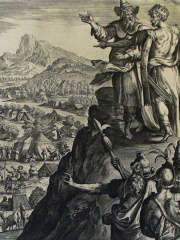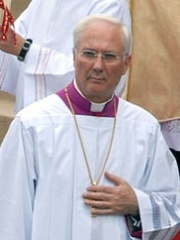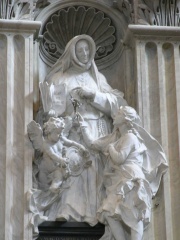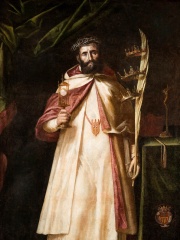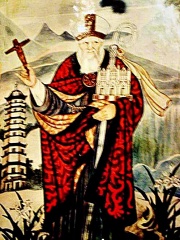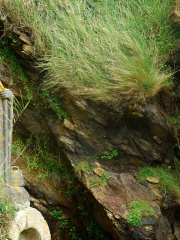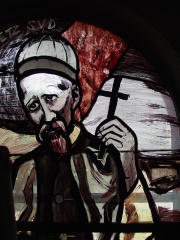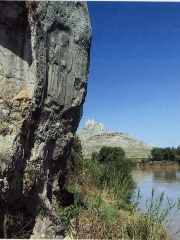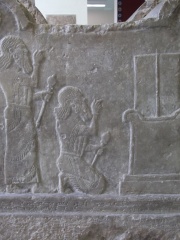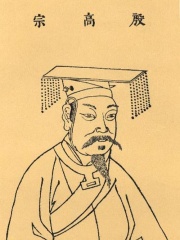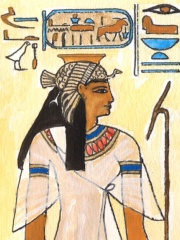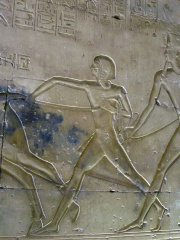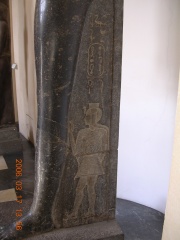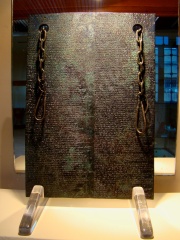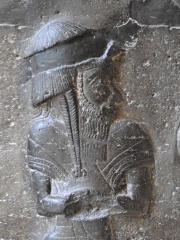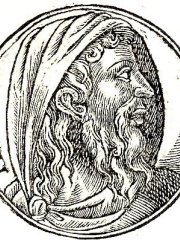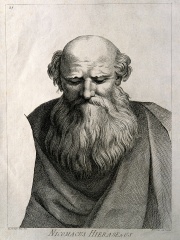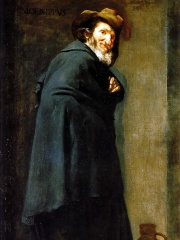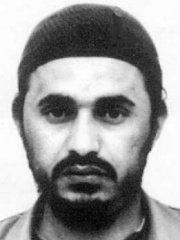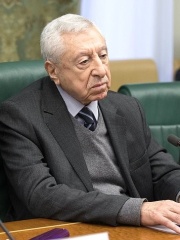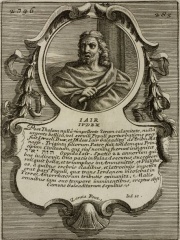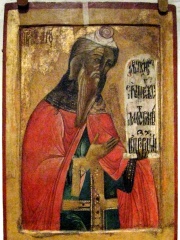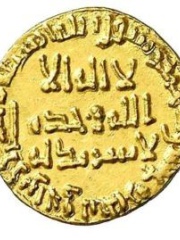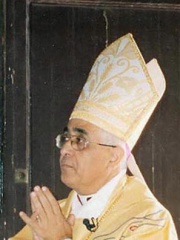RELIGIOUS FIGURE
Phinehas
1300 BC - Today
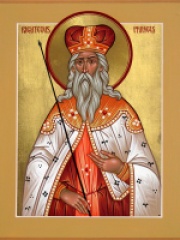
 Phinehas
Phinehas
According to the Hebrew Bible, Phinehas (also spelled Phineas, ; Hebrew: פִּינְחָס, romanized: Pinəḥās, Ancient Greek: Φινεές Phinees, Latin: Phinees) was a priest during the Exodus. The grandson of Aaron and son of Eleazar, the High Priests (Exodus 6:25), he distinguished himself as a youth at Shittim with his zeal against the heresy of Peor. Read more on Wikipedia
His biography is available in 23 different languages on Wikipedia. Phinehas is the 1,307th most popular religious figure (down from 1,189th in 2024), the 13th most popular biography from Jordan (up from 14th in 2019) and the 5th most popular Jordanian Religious Figure.
Memorability Metrics
Page views of Phinehas by language
Among RELIGIOUS FIGURES
Among religious figures, Phinehas ranks 1,307 out of 3,187. Before him are André Vingt-Trois, Balak, Piero Marini, Madeleine Sophie Barat, Hafiz Saeed, and Raymond Nonnatus. After him are Anuruddha, John of Montecorvino, Theophilus Presbyter, Itta of Metz, Gildas, and Joseph Freinademetz.
Most Popular Religious Figures in Wikipedia
Go to all RankingsAndré Vingt-Trois
1942 - 2025
HPI: 64.48
Rank: 1,301
Balak
HPI: 64.48
Rank: 1,302
Piero Marini
1942 - Present
HPI: 64.48
Rank: 1,303
Madeleine Sophie Barat
1779 - 1865
HPI: 64.48
Rank: 1,304
Hafiz Saeed
1950 - Present
HPI: 64.47
Rank: 1,305
Raymond Nonnatus
1204 - 1240
HPI: 64.46
Rank: 1,306
Phinehas
1300 BC - Present
HPI: 64.45
Rank: 1,307
Anuruddha
450 BC - Present
HPI: 64.45
Rank: 1,308
John of Montecorvino
1246 - 1328
HPI: 64.44
Rank: 1,309
Theophilus Presbyter
1070 - 1125
HPI: 64.43
Rank: 1,310
Itta of Metz
592 - 652
HPI: 64.43
Rank: 1,311
Gildas
500 - 570
HPI: 64.43
Rank: 1,312
Joseph Freinademetz
1852 - 1908
HPI: 64.41
Rank: 1,313
Contemporaries
Among people born in 1300 BC, Phinehas ranks 13. Before him are Muwatalli II, Tukulti-Ninurta I, Wu Ding, Bintanath, Amun-her-khepeshef, and Henutmire. After him are Lin Xin, Kurunta, Zu Jia, Shutruk-Nakhunte, Arnuwanda III, and Zu Geng of Shang.
Others Born in 1300 BC
Go to all RankingsMuwatalli II
POLITICIAN
1300 BC - 1300 BC
HPI: 69.01
Rank: 7
Tukulti-Ninurta I
POLITICIAN
1300 BC - 1300 BC
HPI: 66.97
Rank: 8
Wu Ding
POLITICIAN
1300 BC - 1192 BC
HPI: 66.55
Rank: 9
Bintanath
COMPANION
1300 BC - 1300 BC
HPI: 65.76
Rank: 10
Amun-her-khepeshef
RELIGIOUS FIGURE
1300 BC - 1300 BC
HPI: 65.14
Rank: 11
Henutmire
POLITICIAN
1300 BC - 1300 BC
HPI: 64.68
Rank: 12
Phinehas
RELIGIOUS FIGURE
1300 BC - Present
HPI: 64.45
Rank: 13
Lin Xin
POLITICIAN
1300 BC - 1220 BC
HPI: 64.25
Rank: 14
Kurunta
POLITICIAN
1300 BC - 1300 BC
HPI: 64.03
Rank: 15
Zu Jia
POLITICIAN
1300 BC - 1226
HPI: 63.02
Rank: 16
Shutruk-Nakhunte
POLITICIAN
1300 BC - 1155 BC
HPI: 63.00
Rank: 17
Arnuwanda III
POLITICIAN
1300 BC - 1207 BC
HPI: 62.81
Rank: 18
Zu Geng of Shang
POLITICIAN
1300 BC - 1184 BC
HPI: 62.79
Rank: 19
In Jordan
Among people born in Jordan, Phinehas ranks 13 out of 59. Before him are Jephthah (-1118), Nicomachus (60), Menippus (-290), Philodemus (-110), Abu Musab al-Zarqawi (1966), and Balak (null). After him are Nayef Hawatmeh (1938), Haya bint Hussein (1974), Meleager of Gadara (-130), Jair (-1000), Fouad Twal (1940), and Simon bar Giora (100).
Others born in Jordan
Go to all RankingsJephthah
RELIGIOUS FIGURE
1118 BC - 1080 BC
HPI: 72.37
Rank: 7
Nicomachus
MATHEMATICIAN
60 - 120
HPI: 70.80
Rank: 8
Menippus
WRITER
290 BC - 260 BC
HPI: 69.12
Rank: 9
Philodemus
PHILOSOPHER
110 BC - 35 BC
HPI: 66.78
Rank: 10
Abu Musab al-Zarqawi
EXTREMIST
1966 - 2006
HPI: 66.27
Rank: 11
Balak
RELIGIOUS FIGURE
HPI: 64.48
Rank: 12
Phinehas
RELIGIOUS FIGURE
1300 BC - Present
HPI: 64.45
Rank: 13
Nayef Hawatmeh
POLITICIAN
1938 - Present
HPI: 64.44
Rank: 14
Haya bint Hussein
POLITICIAN
1974 - Present
HPI: 62.71
Rank: 15
Meleager of Gadara
WRITER
130 BC - 60 BC
HPI: 62.50
Rank: 16
Jair
RELIGIOUS FIGURE
1000 BC - Present
HPI: 62.26
Rank: 17
Fouad Twal
RELIGIOUS FIGURE
1940 - Present
HPI: 62.05
Rank: 18
Simon bar Giora
SOCIAL ACTIVIST
100 - 70
HPI: 61.73
Rank: 19
Among RELIGIOUS FIGURES In Jordan
Among religious figures born in Jordan, Phinehas ranks 5. Before him are Aaron (-1396), Al-Mansur (714), Jephthah (-1118), and Balak (null). After him are Jair (-1000), Fouad Twal (1940), and Maroun Elias Nimeh Lahham (1948).
Aaron
1396 BC - 1274 BC
HPI: 88.47
Rank: 1
Al-Mansur
714 - 775
HPI: 74.78
Rank: 2
Jephthah
1118 BC - 1080 BC
HPI: 72.37
Rank: 3
Balak
HPI: 64.48
Rank: 4
Phinehas
1300 BC - Present
HPI: 64.45
Rank: 5
Jair
1000 BC - Present
HPI: 62.26
Rank: 6
Fouad Twal
1940 - Present
HPI: 62.05
Rank: 7
Maroun Elias Nimeh Lahham
1948 - Present
HPI: 55.87
Rank: 8

